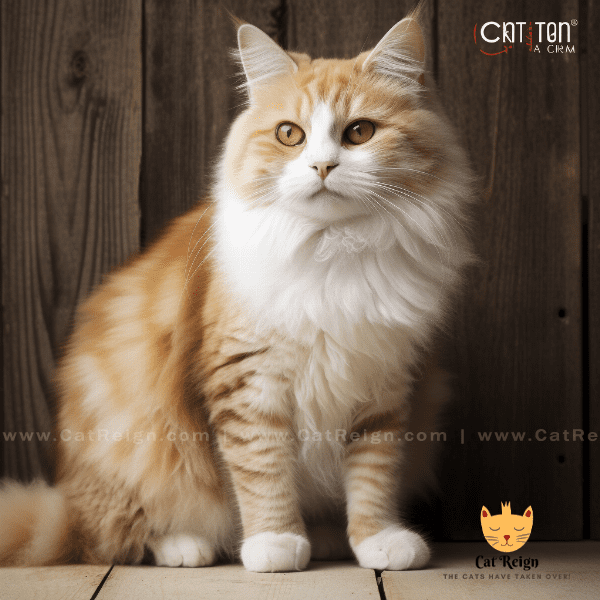Table of Contents
- Introduction to the Cornish Rex Cat Breed
- Creating a Safe and Stimulating Environment
- Feeding Your Cornish Rex Cat
- Grooming and Hygiene
- Exercise and Playtime
- Health Concerns to Watch Out For
- Training and Behavioral Tips
- Traveling with Your Cornish Rex Cat
- Interacting with Other Pets
- Conclusion and Final Thoughts
Introduction to the Cornish Rex Cat Breed
Are you considering adding a new feline friend to your family? If you’re looking for a unique and affectionate breed, you may want to consider the Cornish Rex cat. This breed is known for their curly fur, high energy, and outgoing personalities.
Origin and History of the Cornish Rex Cat
The Cornish Rex breed originated in Cornwall, England in the 1950s. A local farmer discovered a curly-coated kitten in his barn, which he bred with Siamese and British Shorthair cats. The result was a new breed with a soft, wavy coat and a playful personality. Today, the Cornish Rex is recognized by many cat registries worldwide and is a popular choice for cat lovers.
Physical Characteristics of the Cornish Rex Cat
One of the most distinctive features of the Cornish Rex is their curly coat, which is caused by a genetic mutation. The fur is short and fine, and has a soft and silky texture. Their coat comes in a variety of colors and patterns, including solid, tabby, and bi-color.
In addition to their unique coat, the Cornish Rex has a slender and athletic build, with long legs and a long, tapered tail. Their ears are large and pointed, and their eyes are oval-shaped and expressive.
Personality and Temperament of the Cornish Rex Cat
Cornish Rex cats are known for their friendly and outgoing personalities. They are active and playful, and enjoy interacting with their owners. They are intelligent and can learn tricks, making them a great choice for families with children.
Cornish Rex cats are also known for their vocalizations, and they will often “talk” to their owners with a wide range of meows and chirps. They are affectionate and enjoy cuddling with their owners, but they also have a strong independent streak.
Conclusion
Now that you know a bit more about the Cornish Rex cat breed, you can decide if this unique and affectionate feline would be a good fit for your family. Keep in mind that these cats require plenty of attention and stimulation to thrive, so be prepared to provide them with plenty of toys and playtime. With proper care and attention, your Cornish Rex cat can become a beloved member of your family for many years to come.

Creating a Safe and Stimulating Environment
When bringing a Cornish Rex cat into your home, it’s important to create a safe and stimulating environment for them to thrive in. Here are some tips to help you create the perfect home for your new feline friend.
Provide Plenty of Toys and Activities
Cornish Rex cats are highly active and energetic, so it’s important to provide them with plenty of toys and activities to keep them entertained. Toys that allow them to climb, jump, and play will help them burn off excess energy and prevent them from getting bored or destructive. Interactive toys, such as puzzle feeders or laser pointers, can also help stimulate their minds and keep them engaged.
Create a Safe and Secure Space
Cornish Rex cats are curious and love to explore their surroundings, so it’s important to make sure your home is safe and secure for them. This includes ensuring that all windows and doors are securely closed and that there are no potential hazards, such as loose cords or toxic plants, within their reach. Providing a safe and secure space will give your Cornish Rex cat the freedom to explore and play without worry.
Designate a Space for Relaxation
While Cornish Rex cats love to play and explore, they also need a space to relax and unwind. Designating a cozy space for your cat, such as a cat bed or a comfortable chair, will give them a place to retreat to when they need some downtime. This space should be located in a quiet area of your home, away from any potential distractions.
Consider Getting a Companion
Cornish Rex cats are social creatures and thrive on companionship, so consider getting a second cat if you don’t already have one. Another Cornish Rex cat would make an ideal companion for your pet, as they will share similar energy levels and personalities. Alternatively, any cat with a similar temperament would make a good companion for your Cornish Rex.
Conclusion
By following these tips, you can create a safe and stimulating environment for your Cornish Rex cat to thrive in. Providing plenty of toys and activities, creating a safe and secure space, designating a space for relaxation, and considering getting a companion are all important factors to consider when bringing a new feline friend into your home. With proper care and attention, your Cornish Rex cat will be a happy and healthy member of your family for years to come.
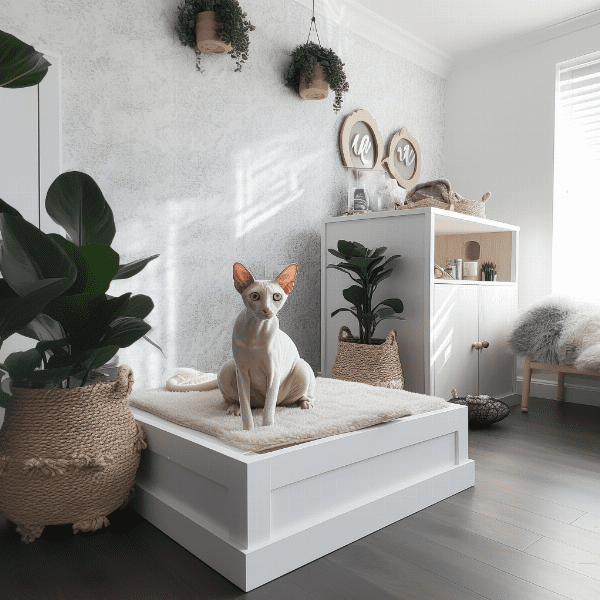
Feeding Your Cornish Rex Cat
Feeding your Cornish Rex cat a healthy and balanced diet is crucial for their overall health and wellbeing. Here are some tips to help you ensure that your furry friend is getting the nutrients they need.
Choose High-Quality Cat Food
When selecting cat food for your Cornish Rex, it’s important to choose a high-quality brand that provides a balanced and complete diet. Look for cat food that contains high-quality protein sources, such as chicken, fish, or turkey, as well as essential vitamins and minerals.
Provide Fresh Water at All Times
In addition to providing your cat with nutritious food, it’s also important to make sure they have access to fresh water at all times. Cats need to stay hydrated, and providing clean and fresh water can help prevent urinary tract problems and other health issues.
Monitor Portion Sizes
Cornish Rex cats have a tendency to overeat, so it’s important to monitor their portion sizes to prevent obesity and other health issues. Follow the recommended portion sizes on the cat food packaging and adjust as necessary based on your cat’s individual needs.
Avoid Table Scraps and Human Food
While it can be tempting to give your Cornish Rex a treat from your own plate, it’s important to avoid feeding them table scraps and human food. Many human foods are not safe for cats and can cause digestive problems or other health issues.
Consider a Feeding Schedule
Establishing a feeding schedule for your Cornish Rex can help prevent overeating and ensure that they are getting the right amount of food. Divide their daily portion into several small meals throughout the day, rather than one large meal.
Conclusion
Feeding your Cornish Rex cat a healthy and balanced diet is essential for their overall health and wellbeing. Choosing high-quality cat food, providing fresh water at all times, monitoring portion sizes, avoiding table scraps and human food, and considering a feeding schedule are all important factors to consider when it comes to feeding your furry friend. With proper care and attention, your Cornish Rex cat will enjoy a long and healthy life by your side.
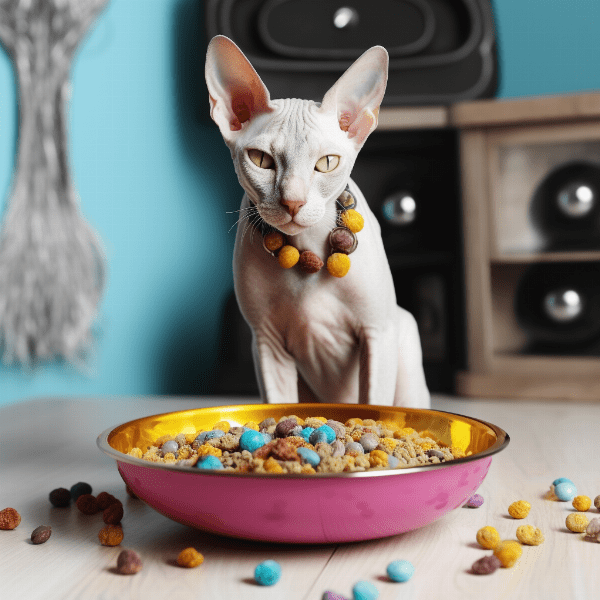
Grooming and Hygiene
Brush Your Cat’s Coat Regularly
While the Cornish Rex’s curly coat is soft and silky, it still requires regular brushing to keep it clean and healthy. Use a soft-bristled brush to gently comb through their fur, starting at the head and working your way down to the tail. This will help remove any loose hair, dirt, or debris, and prevent matting.
Bathe Your Cat as Needed
Unlike other breeds of cats, the Cornish Rex doesn’t produce much oil on their skin, so they don’t require frequent baths. However, if your cat gets into something messy or starts to develop an odor, you may need to give them a bath. Use a gentle cat shampoo and warm water, and be sure to rinse thoroughly to avoid any irritation or skin problems.
Clean Your Cat’s Ears and Eyes
Cornish Rex cats are prone to developing ear and eye infections, so it’s important to clean their ears and eyes regularly. Use a soft, damp cloth to gently wipe away any discharge or debris from their eyes, and use a cotton swab dipped in a vet-approved ear cleaning solution to gently clean their ears.
Trim Your Cat’s Claws
Trimming your cat’s claws regularly can help prevent them from scratching furniture or people. Use a sharp pair of cat nail clippers and clip just the tips of their claws, being careful not to cut too close to the quick.
Watch for Signs of Dental Problems
Dental problems are common in cats, including the Cornish Rex breed. To keep your cat’s teeth and gums healthy, provide them with dental treats and toys, and watch for signs of dental problems such as bad breath or swollen gums. Regular dental check-ups with your veterinarian can also help prevent and treat dental problems.
Conclusion
Grooming and hygiene are important aspects of caring for your Cornish Rex cat. Brushing their coat regularly, bathing them as needed, cleaning their ears and eyes, trimming their claws, and watching for signs of dental problems are all important factors to consider when it comes to keeping your furry friend looking and feeling their best. With proper care and attention, your Cornish Rex cat will be a healthy and happy member of your family for years to come.
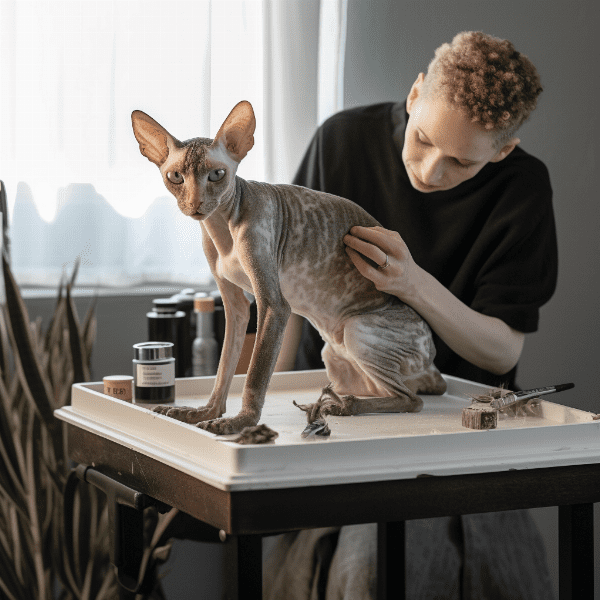
Exercise and Playtime
Cornish Rex cats are highly active and energetic, so providing them with plenty of exercise and playtime is essential for their physical and mental wellbeing. Here are some tips to help you keep your furry friend happy and healthy.
Provide Plenty of Toys
Cornish Rex cats love to play, so providing them with a variety of toys is important for their physical and mental stimulation. Toys that allow them to climb, jump, and play are ideal, as they mimic the natural activities that cats would engage in in the wild.
Engage in Interactive Play
Interactive play is also important for your Cornish Rex cat, as it allows them to bond with you and provides them with mental stimulation. Use toys such as feather wands or laser pointers to engage your cat in play, and be sure to vary the activities to keep them engaged.
Provide Access to High Places
Cornish Rex cats love to climb and explore, so providing them with access to high places such as cat trees or shelves can help satisfy their natural instincts. This will also give them a safe and secure space to retreat to when they need some downtime.
Encourage Exercise Through Food
Cornish Rex cats are prone to overeating, so using food puzzles or treat balls can help encourage them to exercise while also providing mental stimulation. These types of toys require your cat to work for their food, which can help prevent boredom and overeating.
Conclusion
Providing your Cornish Rex cat with plenty of exercise and playtime is essential for their physical and mental wellbeing. Providing plenty of toys, engaging in interactive play, providing access to high places, encouraging exercise through food, and considering a companion are all important factors to consider when it comes to keeping your furry friend happy and healthy. With proper care and attention, your Cornish Rex cat will be a happy and active member of your family for years to come.
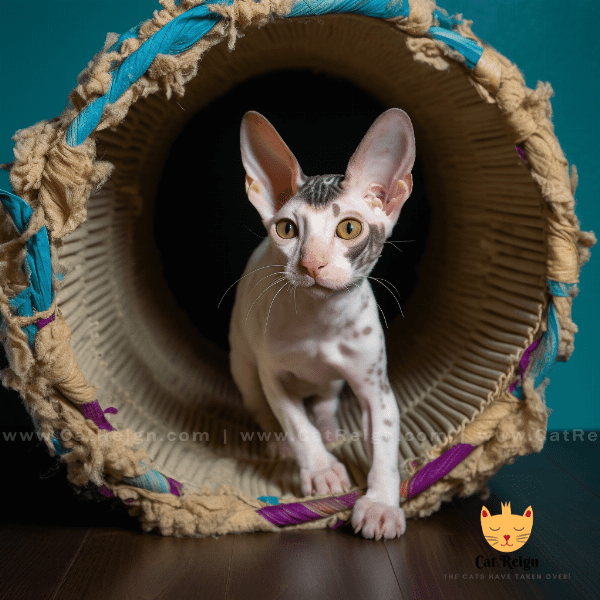
Health Concerns to Watch Out For
Like all breeds of cats, the Cornish Rex is prone to certain health issues that owners should be aware of. Here are some common health concerns to watch out for in your Cornish Rex cat.
Respiratory Problems
Cornish Rex cats are prone to respiratory problems such as asthma and bronchitis. Symptoms of respiratory problems include coughing, wheezing, and difficulty breathing. If you notice any of these symptoms, take your cat to the veterinarian for a check-up.
Skin Conditions
The Cornish Rex’s curly coat can make them prone to skin conditions such as dry skin or fungal infections. Symptoms of skin conditions include itching, redness, and flaking. Keeping your cat’s coat clean and well-groomed can help prevent skin problems.
Urinary Tract Problems
Urinary tract problems such as urinary tract infections or blockages are common in cats, including the Cornish Rex breed. Symptoms of urinary tract problems include frequent urination, straining to urinate, and blood in the urine. If you notice any of these symptoms, take your cat to the veterinarian for a check-up.
Dental Problems
Dental problems such as gingivitis or tooth decay are common in cats, including the Cornish Rex breed. Symptoms of dental problems include bad breath, swollen gums, and difficulty eating. Providing your cat with dental treats and toys, and scheduling regular dental check-ups with your veterinarian, can help prevent dental problems.
Hypertrophic Cardiomyopathy
Hypertrophic cardiomyopathy is a genetic heart condition that is common in many breeds of cats, including the Cornish Rex. Symptoms of this condition include difficulty breathing, lethargy, and fainting. Regular check-ups with your veterinarian can help detect and treat this condition early.
Conclusion
While the Cornish Rex is a generally healthy breed of cat, they are prone to certain health issues that owners should be aware of. Respiratory problems, skin conditions, urinary tract problems, dental problems, and hypertrophic cardiomyopathy are all common health concerns to watch out for. Regular check-ups with your veterinarian and providing your cat with proper care and attention can help prevent and treat these health issues, ensuring that your Cornish Rex cat enjoys a happy and healthy life by your side.

Training and Behavioral Tips
Training and behavioral management are important aspects of caring for your Cornish Rex cat. Here are some tips to help you train and manage your furry friend’s behavior.
Use Positive Reinforcement
Positive reinforcement is an effective training method for cats, including the Cornish Rex breed. Use treats or praise to reward your cat for good behavior, such as using the litter box or scratching on a scratching post. This will help reinforce positive behavior and discourage negative behavior.
Provide a Scratching Post
Cornish Rex cats love to scratch, so providing them with a scratching post is essential for managing their behavior. Place the scratching post in a location where your cat likes to scratch, such as near a favorite sleeping spot, and encourage them to use it by scratching it yourself and providing treats or praise when they use it.
Use Deterrents for Undesirable Behaviors
If your cat exhibits undesirable behavior, such as scratching furniture or jumping on counters, use deterrents such as double-sided tape or aluminum foil to discourage the behavior. You can also use a spray bottle filled with water to gently discourage behavior that you don’t want to encourage.
Establish a Routine
Establishing a routine can help manage your Cornish Rex cat’s behavior and make them feel more comfortable in their environment. This includes feeding them at the same time each day, providing playtime at regular intervals, and establishing a regular sleep schedule.
Seek Professional Help for Behavioral Issues
If your Cornish Rex cat exhibits persistent behavioral problems, such as aggression or excessive scratching, seek help from a professional cat behaviorist. A behaviorist can help you identify the root cause of the behavior and provide strategies to manage it effectively.
Conclusion
Training and behavioral management are important aspects of caring for your Cornish Rex cat. Using positive reinforcement, providing a scratching post, using deterrents for undesirable behavior, establishing a routine, and seeking professional help for behavioral issues are all important factors to consider when it comes to managing your furry friend’s behavior. With proper care and attention, your Cornish Rex cat will be a well-behaved and happy member of your family for years to come.

Traveling with Your Cornish Rex Cat
Traveling with your Cornish Rex cat can be a fun and rewarding experience, but it also requires careful planning and preparation. Here are some tips to help you and your furry friend have a safe and enjoyable journey.
Prepare Your Cat for Travel
Before you travel with your Cornish Rex, make sure they are up-to-date on their vaccinations and have a health certificate from your veterinarian. You should also acclimate them to their carrier by leaving it out and open for them to explore, and providing them with treats or toys inside.
Choose the Right Carrier
Choosing the right carrier is important for your Cornish Rex’s comfort and safety during travel. Look for a carrier that is the appropriate size for your cat, with plenty of ventilation and a secure locking mechanism.
Pack Essentials for Your Cat
When traveling with your Cornish Rex, make sure to pack all of their essentials, including food, water, litter, and any necessary medications. You should also pack their favorite toys and a familiar blanket or bedding to help them feel more comfortable during travel.
Secure Your Cat in the Car
When traveling by car, it’s important to secure your Cornish Rex in a carrier, and place the carrier in a secure location, such as the backseat. This will help keep your cat safe and prevent them from becoming a distraction while driving.
Consider Sedation for Nervous Cats
If your Cornish Rex becomes nervous or anxious during travel, talk to your veterinarian about the possibility of using a sedative to help them relax. This can make the travel experience more comfortable and less stressful for your furry friend.
Conclusion
Traveling with your Cornish Rex cat requires careful planning and preparation, but it can be a fun and rewarding experience for both you and your furry friend. Preparing your cat for travel, choosing the right carrier, packing essentials, securing your cat in the car, and considering sedation for nervous cats are all important factors to consider when it comes to traveling with your furry friend. With proper care and attention, your Cornish Rex cat can enjoy new adventures and experiences by your side.

Interacting with Other Pets
Cornish Rex cats are known for their friendly and outgoing personalities, and they can get along well with other pets in the household. Here are some tips to help you introduce your Cornish Rex to other pets and ensure a harmonious living environment.
Introduce Your Cat Slowly
When introducing your Cornish Rex to other pets in the household, such as dogs or other cats, it’s important to do so slowly and carefully. Keep your cat in a separate room at first and allow them to sniff and explore each other’s scents through a closed door. Gradually introduce them to each other in a controlled environment, such as on opposite sides of a baby gate, and monitor their interactions closely.
Supervise Interactions
When your Cornish Rex cat and other pets are interacting, it’s important to supervise them closely to ensure that they are getting along well. If any aggressive behavior is exhibited, such as hissing or growling, separate them and try again at a later time.
Provide Separate Resources
To prevent any territorial behavior, such as food or toy guarding, it’s important to provide separate resources for each pet. This includes separate food and water bowls, litter boxes, and toys.
Give Your Cat Plenty of Attention
While introducing your Cornish Rex to other pets, it’s important to give them plenty of attention and one-on-one time. This will help them feel secure and loved, and prevent any feelings of jealousy or resentment towards the other pets.
Consider a Companion
If your Cornish Rex is an only cat, consider getting them a companion cat with a similar temperament. This can provide your cat with a playmate and a source of social interaction, which is important for their mental and emotional wellbeing.
Conclusion
Introducing your Cornish Rex cat to other pets in the household requires patience and careful planning, but it can be a rewarding experience for all involved. Introduce your cat slowly, supervise interactions, provide separate resources, give your cat plenty of attention, and consider a companion cat if necessary. With proper care and attention, your Cornish Rex can live harmoniously with other pets in your household.

Conclusion and Final Thoughts
Caring for a Cornish Rex cat can be a rewarding and enjoyable experience. With their playful personalities, curly coats, and affectionate nature, they make wonderful companions. Here are some final thoughts and tips to keep in mind when caring for your Cornish Rex.
Remember the Basics
Providing your Cornish Rex with proper nutrition, grooming, and medical care is essential for their overall health and wellbeing. Make sure to provide them with a healthy diet, regular grooming sessions, and routine check-ups with your veterinarian.
Provide Plenty of Stimulation
Cornish Rex cats are active and curious by nature, so providing them with plenty of opportunities for play and exploration is important for their mental and physical health. Toys, scratching posts, and playtime with their human family can all provide stimulation and enrichment for your furry friend.
Consider Your Cat’s Personality
Every Cornish Rex cat is unique, with their own personality and preferences. When caring for your cat, it’s important to consider their individual needs and cater to them accordingly. Some cats may prefer a quiet and calm environment, while others may thrive in a more active and social household.
Enjoy Your Time with Your Furry Friend
Finally, remember to enjoy your time with your Cornish Rex cat. Whether it’s snuggling on the couch or playing a game of chase, spending time with your furry friend can bring joy and companionship into your life.
Conclusion
Caring for a Cornish Rex cat requires love, patience, and attention to detail. Remembering the basics, providing plenty of stimulation, considering your cat’s personality, and enjoying your time with your furry friend are all important factors to keep in mind. With proper care and attention, your Cornish Rex cat can be a loyal and loving companion for years to come.



